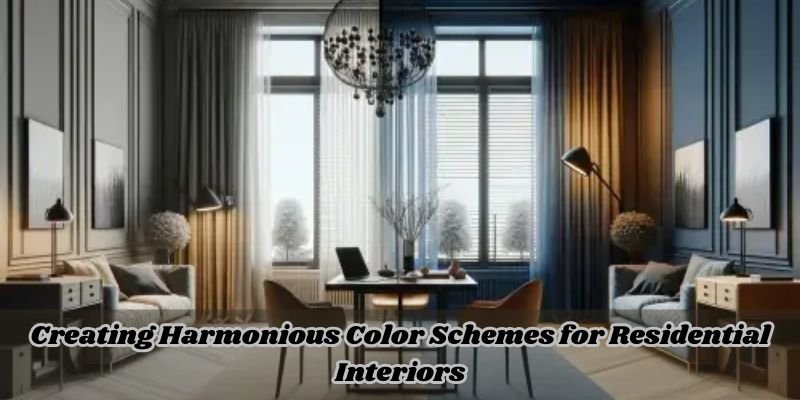One of the key aspects to the design of your home is actually a color scheme that can break or make the general ambiance. Colours can actually be welcoming to create a comfortable and expansive environment in a given space or affect mood. Considering a house as a residence, it is also about ensuring a balance and coherence in each room with this colorful and dynamic city of Chennai. From your living room to your bedroom, or even a modular kitchen, understanding the interplay between colors is crucial to creating something beautiful and functional within the space.
Understanding the Role of Color in Interior Design
Colour fundamentally influences the mood in the room. Emotions may be evoked; it makes one feel if a place is either spacious or tiny; it makes people feel the room can be very uncomfortable. Warm colours, like reds, yellows, and oranges, bring warmness into an atmosphere that gives off inviting comfort. Cool colours, on the other hand, like blues and greens, help induce calmness and relaxation.
In residential interiors, it is critical to consider how different rooms serve different purposes. How the color scheme for a living room-the space possibly used for socialization and entertaining-appears would be very different from that of a bedroom, where the very intention is relaxation and rest. When designing Interiors in Chennai , consider the climate, natural light, and even the cultural influences that might guide your choices.
The Basics of Harmonious Color Schemes
A harmonious color scheme is all about balance. The best way to achieve this is by choosing colors that work well together and complement each other. There are several methods for creating harmonious color schemes:
- Monochromatic Color Scheme
This technique uses varying tints and tones of a single color. It’s a very simple and classy way to guarantee your colors will be in harmony. For instance, using various shades of blue in a room creates a soothing and harmonious environment. Analogous schemes work well in small rooms as they make rooms appear larger and more cohesive.
- Analogous Color Scheme
The colors side by side the color wheel constitute analogous color pairs, including yellow, blue and green. With these colours shades, an inviting, calming appearance is attained where spaces flow amicably for example using all shades of the green or all earth tones color in the family room will give that beautiful seamless integration while connecting indoor views with the open green spaces available in Chennai to the room.
- Complementary colors fall opposite each other on the color wheel, like blue and orange, or green and red. Often, it gives a very bold contrast that pops and draws attention, ideal for making statements. Nevertheless, using too many complementary colors could be overwhelming to the eye, thus a room that doesn’t need it should be balanced with neutral tones.
- Triadic Color Scheme
A triadic color scheme employs three colors equidistantly spaced on the color wheel. This arrangement makes for a dynamic, energetic space. Using red, yellow, and blue, for example, can result in a dramatic, lively atmosphere, but by using muted or pastel versions of these colors, the space may be kept feeling balanced and comfortable.
Factors to Consider When Creating Color Schemes for Residential Interiors
The home’s colors when created to flow harmoniously involve a consideration of several factors such that they create a beautiful scene with the entire design.
- Purpose of Room
A room’s purpose will definitely dictate the colours chosen. For a kitchen, vibrant colours such as yellow or red will stimulate hunger and energy; cool tones of blue will have a soothing effect in bedrooms. For a Modular Kitchen, it will be nice to have clean and efficient hues like white, gray, or subtle pastel shades that have a modern look and feel to it.
- Lighting
The quantity of natural light that reaches a room greatly influences how colors appear. Rooms that have enough sunlight can handle deeper, richer colors, whereas spaces that do not have much sunlight can benefit from brighter, lighter colors to create a sense of openness and airiness.
- Cultural Influence
In Chennai, cultural and traditional colors are also important, such as terracotta, ochre, and deep red, which really dominate the way traditional architecture looks and can be combined with a touch of modernity to give a feel of warmth and richness of the culture.
- Texture and Material
The material used in the room like wood, metal, or stone also has an impact on how colors interact. For example, a natural wood finish will go amazing in a Modular Kitchen with neutral tones like beige, cream, or soft gray to create a modern, organic feel.
Harmonizing Your Home with Modular Kitchens
A modern kitchen is not just a space to prepare meals but a family gathering place where they can dine and even entertain. Design the color scheme of your Modular Kitchen with a palette that complements the sleek, clean lines of modular furniture and creates a welcoming and practical environment. For instance, an amalgam of white cabinet fronts with a complement of stainless steel appliances paired with wood details offers a clean and elegant timelessness. When desiring added warmth, then integrate soft, earthy shades of beige or light brown on countertops and floor.
Add pops of color in accessories or backsplashes in green or yellow to give your kitchen energy without overwhelming the space. Remember to keep the practical aspects in mind and choose colors that are easy to maintain and won’t easily show dirt or wear.
Conclusion
The art of designing harmonious color schemes for residential interiors in Chennai or any other city is an art that requires understanding the space, lighting, and cultural influences. Whether it’s a serene bedroom with cool tones or an energetic, inviting kitchen with complementary colors, the key is balance. Using one of the various techniques to harmonize your color options and carefully planning your Modular Kitchen Chennai layout will surely result in an aesthetically pleasing yet functional home.














